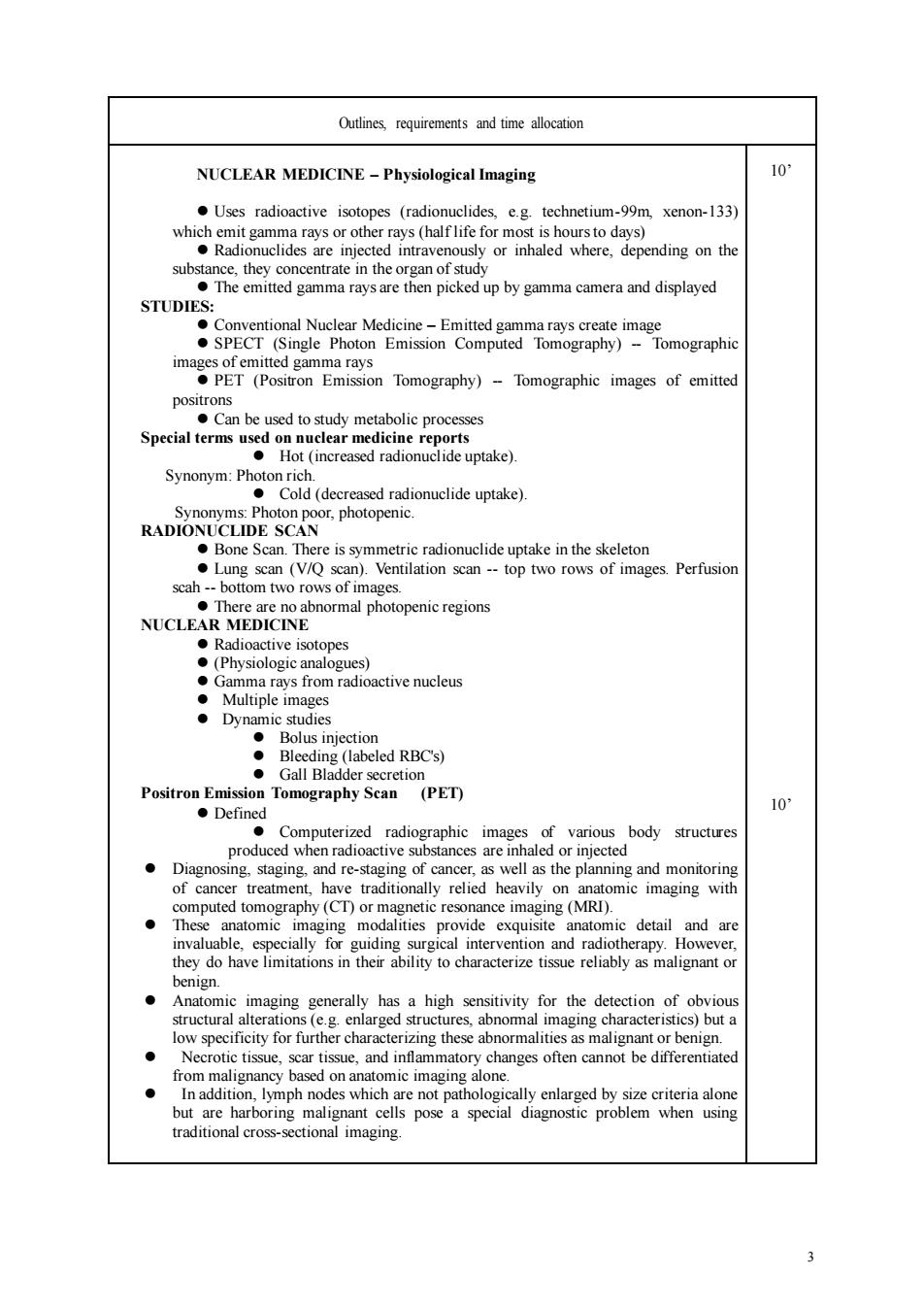正在加载图片...

Outlines requirements and time allocation NUCLEAR MEDICINE-Physiological Imaging 0. Uses radioactive isotopes (radionuclides,e.g technetium-99m,xenon-133) substance.they concentrate in theorgn of stu nding on the STUDIES The emitted gamma rays are then picked up by gamma camera and displayed Conventional Nuclear Medicine-Emitted gamma rays create image SPECT (Single Photon Emission Computed Tomography)-Tomographic )Tomogaphiem ofem positrons Specialcrsnuaodemib Hot(increased radionuclide uptake). Synonym:Ph (uptake) etric radionuclide untake in the skeletor Lung scan (V/scan)Ventilation scantop two rows of images.Perfusion NUCLEAR MEDICINE penic regions Radioactive isopes (PET) ●Defined 10 radio of cancer.as well as the planning and monitoring of cancer treatment,have traditionally relied heavilyon videce ima nic detail and are for guiding Anatomic imaging generally has a high sensitivity for the detection of obvious structural alterati (e.g.enlarged structures,a bnomal imaging characterist cs)but a from maligna traditional cross-sectional imaging. 3 Outlines, requirements and time allocation NUCLEAR MEDICINE – Physiological Imaging ⚫ Uses radioactive isotopes (radionuclides, e.g. technetium-99m, xenon-133) which emit gamma rays or other rays (half life for most is hours to days) ⚫ Radionuclides are injected intravenously or inhaled where, depending on the substance, they concentrate in the organ of study ⚫ The emitted gamma rays are then picked up by gamma camera and displayed STUDIES: ⚫ Conventional Nuclear Medicine – Emitted gamma rays create image ⚫ SPECT (Single Photon Emission Computed Tomography) - Tomographic images of emitted gamma rays ⚫ PET (Positron Emission Tomography) - Tomographic images of emitted positrons ⚫ Can be used to study metabolic processes Special terms used on nuclear medicine reports ⚫ Hot (increased radionuclide uptake). Synonym: Photon rich. ⚫ Cold (decreased radionuclide uptake). Synonyms: Photon poor, photopenic. RADIONUCLIDE SCAN ⚫ Bone Scan. There is symmetric radionuclide uptake in the skeleton ⚫ Lung scan (V/Q scan). Ventilation scan - top two rows of images. Perfusion scah - bottom two rows of images. ⚫ There are no abnormal photopenic regions NUCLEAR MEDICINE ⚫ Radioactive isotopes ⚫ (Physiologic analogues) ⚫ Gamma rays from radioactive nucleus ⚫ Multiple images ⚫ Dynamic studies ⚫ Bolus injection ⚫ Bleeding (labeled RBC's) ⚫ Gall Bladder secretion Positron Emission Tomography Scan (PET) ⚫ Defined ⚫ Computerized radiographic images of various body structures produced when radioactive substances are inhaled or injected ⚫ Diagnosing, staging, and re-staging of cancer, as well as the planning and monitoring of cancer treatment, have traditionally relied heavily on anatomic imaging with computed tomography (CT) or magnetic resonance imaging (MRI). ⚫ These anatomic imaging modalities provide exquisite anatomic detail and are invaluable, especially for guiding surgical intervention and radiotherapy. However, they do have limitations in their ability to characterize tissue reliably as malignant or benign. ⚫ Anatomic imaging generally has a high sensitivity for the detection of obvious structural alterations (e.g. enlarged structures, abnormal imaging characteristics) but a low specificity for further characterizing these abnormalities as malignant or benign. ⚫ Necrotic tissue, scar tissue, and inflammatory changes often cannot be differentiated from malignancy based on anatomic imaging alone. ⚫ In addition, lymph nodes which are not pathologically enlarged by size criteria alone but are harboring malignant cells pose a special diagnostic problem when using traditional cross-sectional imaging. 10’ 10’